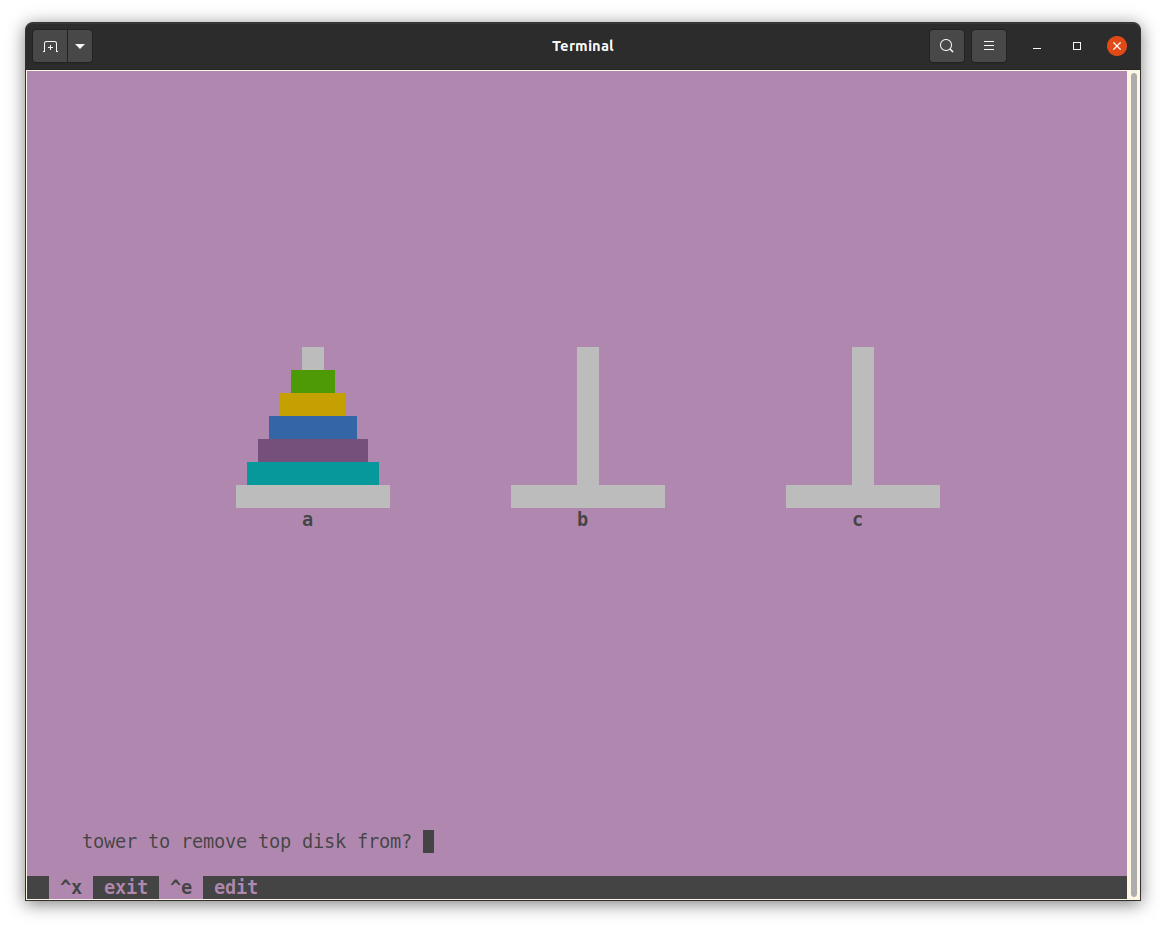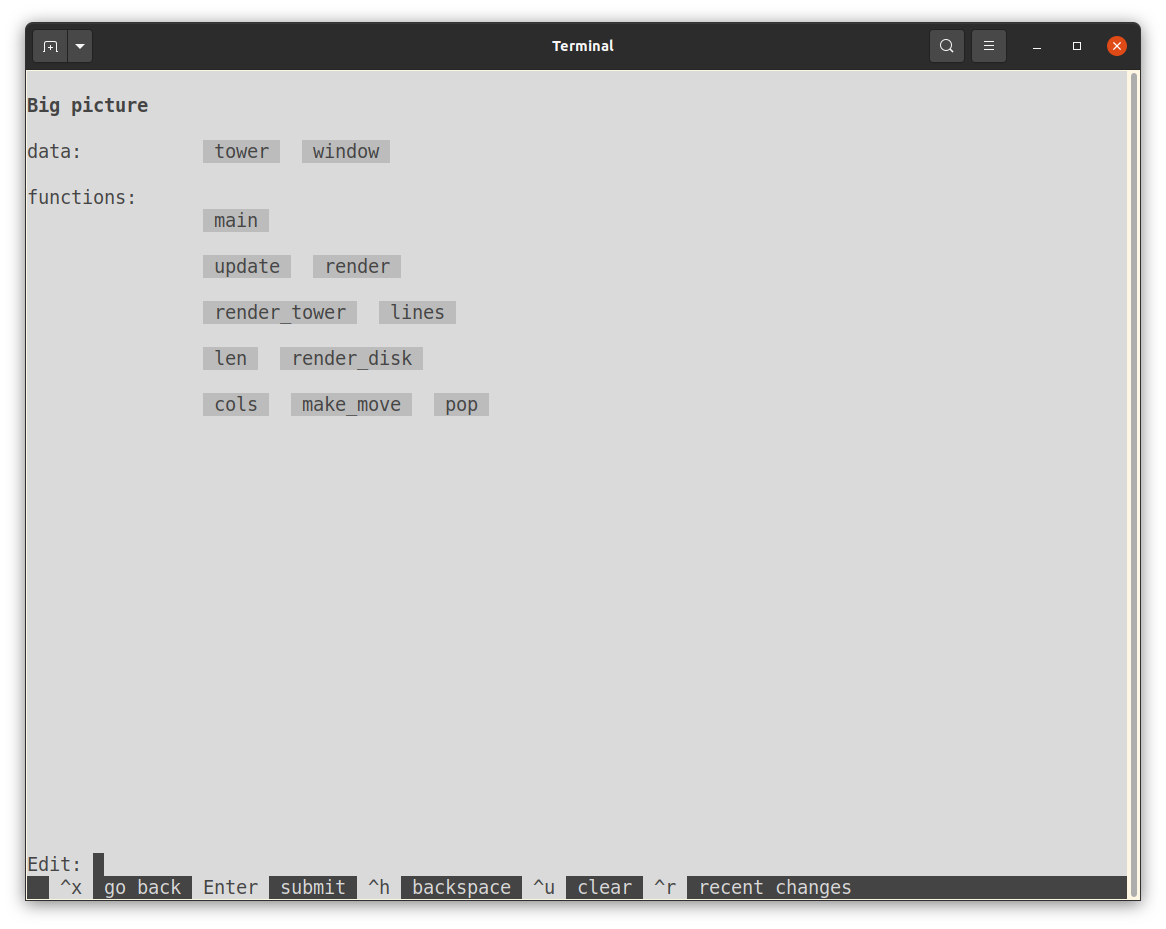|
|
||
|---|---|---|
| doc | ||
| sandboxing | ||
| src | ||
| .gitattributes | ||
| .gitignore | ||
| COPYRIGHT.md | ||
| Makefile | ||
| README.md | ||
| chesstv.tlv | ||
| counter.tlv | ||
| gemini.tlv | ||
| hanoi.tlv | ||
| life.tlv | ||
| manual_tests | ||
| shell.nix | ||
| template.tlv | ||
| toot-toot.tlv | ||
| tour.md | ||
README.md
Teliva - an environment for end-user programming
“Enable all people to modify the software they use in the course of using it.” — https://futureofcoding.org/episodes/033.html
“What if we, and all computer users, could reach in and modify our favorite apps?” — https://www.inkandswitch.com/end-user-programming
“Software must be as easy to change as it is to use.” — https://malleable.systems
What's this, then?
An extremely naïve, brutalist environment for little text-mode Lua apps that are easy to modify.
Here's how you run one of the example apps (the Tower of Hanoi):
git clone https://github.com/akkartik/teliva
cd teliva
make linux # replace with 'macosx' or 'bsd' depending on your OS
src/teliva hanoi.tlv

No matter what app you run, you are always guaranteed access to a single
obvious, consistent way (currently the hotkey ctrl-e) to inspect its
sources.
When you look under the hood of an app, the first thing you see is a big-picture view which shows the app's major data structures and a top-down view of the app's code.

Select a definition, make a change, hit ctrl-e again, and the app will run
with your updates. (video)
You will need some Unix-like platform with a C compiler and the ncurses and openssl libraries. Some possible commands to install them, depending on your OS and package manager of choice:
guix shell -D lua openssl -- make linuxnix-shell --pure(from a directory containing shell.nix in this repo)sudo apt install libncursesw6-dev opensslbrew install ncurses openssl
So far I've tested Teliva on Linux, Mac OS X and OpenBSD; it should also work on other flavors of BSD, WSL on Windows, etc. with only minor modifications.
What else can it do?
Anything! Some more sample apps to try out:
-
Conway's Game of Life, as an example of an animated local app.
src/teliva life.tlv -
A viewer for LiChess TV, as an example of animation and accessing a remote API over a network.
src/teliva chesstv.tlv -
A browser for the Gemini protocol.
src/teliva gemini.tlv
These are just a start. The sky is the limit.
So, just a programming language, then?
There's one big difference with other programming languages: Teliva apps are sandboxed like a browser. Most languages assume the fiction that the person running a program trusts all the code in the program. This assumption hasn't been valid since a decade after the Unix big bang, if then. Teliva takes on the reality that apps can get complex and use code written by strangers. In response, Teliva tries to always summarize for you what the program you're running is trying to do, and to ask you before a random app tries to do something sensitive. Permissions you grant a Teliva app will be flexible and easy to understand. Browsers and mobile apps today tend to make you choose between those two properties.
Sandboxing is still in progress. It isn't yet safe to run untrusted Teliva apps you download from the internet. (Fortunately you're unlikely to run into any such apps.)
Isn't this just an IDE?
There's one big difference: these apps are not intended to be runnable outside of the Teliva environment. Editing the sources and visualizing permissions granted will always be core features that are front and center in the UI.
A second, more subtle difference: it's primarily an environment for running apps, and only secondarily for editing them. Starting up the environment puts you in a running app by default. Creating an app from a clean slate is a low-priority use case, as is lots of specialized support for developing complex apps. The sweet spot for Teliva is simple apps that people will want to edit after using for a while.
Why Lua?
It's reputedly the fastest interpreted language per line of implementation code.
Will it run any Lua program?
Not quite. My priority is providing a good experience for newcomers to comprehend and modify the programs they use. If it's not clear how to provide that experience for some kinds of Lua programs, I'd rather disable support for them in Teliva and let people use regular Lua. Or other platforms!
-
This approach doesn't make sense for batch programs, I think. I also don't yet have a good story for building server programs in this way.
-
I don't know how to obtain a simple, shallow graphics stack, so there's no support for graphics at the moment.
-
Teliva initializes the ncurses library by default, so apps should assume they have access to a (color, UTF-8) text-mode window for printing text to, and a keyboard for reading keystrokes from.
-
Teliva doesn't use files for source code, so the
requirekeyword no longer makes sense. You get some libraries preloaded (see below). Beyond those, apps should include all Lua code they want to use. -
I want to provide sandboxed access to system resources (file system, network, etc.) which will likely create incompatibilities with the standard library. I'm disinclined to try to ‘improve’ on Lua syntax, however. It's not my favorite, but it's good enough.
-
To create a well-behaved sandbox, Teliva doesn't support adding libraries with C bindings beyond the few it starts up with.
-
Functions that start with
test_are special. They're considered automated tests and called without arguments every time an app starts up. -
The function
mainis special. It runs every time an app starts up, if all its automated tests pass.
Teliva is not tested much at all yet. This is my first time programming either in Lua or within Lua. So bug reports are most appreciated if Lua programs behave unexpectedly under Teliva.
What's included?
- Lua 5.1
- The ncurses library for building text-mode user interfaces. (Alternative documentation)
- The Kilo text editor, modified to use ncurses. (Read more about it in this fantastic walk-through.)
- The lcurses binding for ncurses (as
module
curses). - The luasocket library of
networking primitives (modules
socket,http,url,headers,mime,ltn12). - The luasec library for HTTPS support
(modules
httpsandssl). - The json.lua library for
serializing/deserializing to JSON (module
json).
The modules mentioned above are always available, just like standard Lua 5.1 libraries. However, a few things are different from conventional Lua:
- Some functions are disabled because I don't know how to sandbox them
effectively:
os.executeio.popen
- Some functions are disabled because they don't seem to make sense in an
ncurses environment. This includes the Lua notions of default files, which
start out as stdin/stdout.
io.input,io.readio.output,io.write,io.flush
- Some functions in lcurses have additional smarts. Teliva is consistent with the underlying ncurses.
While most things in these modules are currently available, I expect to delete capabilities throughout this stack as I discover features that don't fit well with the Teliva experience. If you find Teliva of use, please introduce yourself to me so that I am aware of your use cases. Anybody who is interested can gain a say in its future direction.
What's with the name?
Teliva is the Tamil root for ‘clear’. Very much aspirational.
Known issues
-
Colors are currently hardcoded. You get a light background even if your terminal started out dark. To tweak colors, look for calls to
assume_default_colors()andinit_pair(), either in .tlv files for a specific app, or in the C sources for the standard code browser/editor. -
Backspace is known to not work in some configurations. As a workaround, typing
ctrl-htends to work in those situations. -
Keys outside the main keyboard area are mostly not supported. This includes the delete key when it's set away from the main keyboard area. (Macs call the backspace key “delete”; it should behave like backspace. As a consequence the menu sometimes mentions keys that don't work, just to encourage people to try options.)